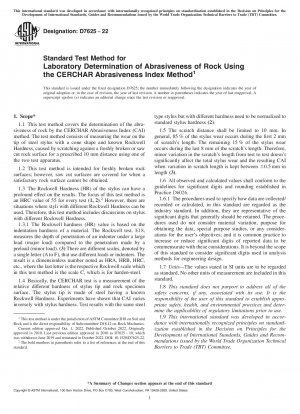ASTM D7625-22
Standard Test Method for Laboratory Determination of Abrasiveness of Rock Using the CERCHAR Abrasiveness Index Method
- Standard No.
- ASTM D7625-22
- Release Date
- 2022
- Published By
- American Society for Testing and Materials (ASTM)
- Latest
- ASTM D7625-22
- Scope
- 1.1 This test method covers the determination of the abrasiveness of rock by the CERCHAR Abrasiveness Index (CAI) method. The test method consists of measuring the wear on the tip of steel stylus with a cone shape and known Rockwell Hardness, caused by scratching against a freshly broken or saw cut rock surface for a prescribed 10 mm distance using one of the two test apparatus. 1.2 This test method is intended for freshly broken rock surfaces; however, saw cut surfaces are covered for when a satisfactory rock surface cannot be obtained. 1.3 The Rockwell Hardness (HR) of the stylus can have a profound effect on the results. The focus of this test method is an HRC value of 55 for every test (1, 2).2 However, there are situations where styli with different Rockwell Hardness can be used. Therefore, this test method includes discussions on stylus with different Rockwell Hardness. 1.3.1 The Rockwell hardness (HR) value is based on the indentation hardness of a material. The Rockwell test, E18, measures the depth of penetration of an indenter under a large load (major load) compared to the penetration made by a preload (minor load). (3) There are different scales, denoted by a single letter (A to F), that use different loads or indenters. The result is a dimensionless number noted as HRA, HRB, HRC, etc., where the last letter is the respective Rockwell scale which in this test method is the scale C, which is for harden{steel. 1.4 Basically, the CERCHAR test is a measurement of the relative different hardness of stylus tip and rock specimen surface. The stylus tip is made of steel having a known Rockwell Hardness. Experiments have shown that CAI varies inversely with stylus hardness. Test results with the same steel type stylus but with different hardness need to be normalized to standard stylus hardness (2). 1.5 The scratch distance shall be limited to 10 mm. In general, 85 % of the stylus wear occurs during the first 2 mm of scratch’s length. The remaining 15 % of the stylus wear occurs during the last 8 mm of the scratch’s length. Therefore, minor variation in the scratch’s length from test to test doesn’t significantly affect the total stylus wear and the resulting CAI when variation in scratch length is kept between 60.5 mm in length (3). 1.6 All observed and calculated values shall conform to the guidelines for significant digits and rounding established in Practice D6026. 1.6.1 The procedures used to specify how data are collected/ recorded or calculated, in this standard are regarded as the industry standard. In addition, they are representative of the significant digits that generally should be retained. The procedures used do not consider material variation, purpose for obtaining the data, special purpose studies, or any considerations for the user’s objectives; and it is common practice to increase or reduce significant digits of reported data to be commensurate with these considerations. It is beyond the scope of this standard to consider significant digits used in analysis methods for engineering design. 1.7 Units—The values stated in SI units are to be regarded as standard. No other units of measurement are included in this standard. 1.8 This standard does not purport to address all of the safety concerns, if any, associated with its use. It is the responsibility of the user of this standard to establish appropriate safety, health, and environmental practices and determine the applicability of regulatory limitations prior to use. 1.9 This international standard was developed in accordance with internationally recognized principles on standardization established in the Decision on Principles for the Development of International Standards, Guides and Recommendations issued by the World Trade Organization Technical Barriers to Trade (TBT) Committee. 1 This test method is under the jurisdiction of ASTM Committee D18 on Soil and Rock and is the direct responsibility of Subcommittee D18.12 on Rock Mechanics. Current edition approved Oct. 1, 2022. Published October 2022. Originally approved in 2010. Last previous edition approved in 2010 as D7625 – 10, which was withdrawn June 2019 and reinstated in October 2022. DOI: 10.1520/D7625-22. 2 The bold numbers in parenthesis refer to a list of references at the end of this standard. *A Summary of Changes section appears at the end of this standard Copyright © ASTM International, 100 Barr Harbor Drive, PO Box C700, West Conshohocken, PA 19428-2959. United States This international standard was developed in accordance with internationally recognized principles on standardization established in the Decision on Principles for the Development of International Standards, Guides and Recommendations issued by the World Trade Organization Technical Barriers to Trade (TBT) Committee. 1 2. Referenced Documents
ASTM D7625-22 Referenced Document
- ASTM D2216 Standard Test Method for Laboratory Determination of Water (Moisture) Content of Soil and Rock by Mass
- ASTM D3740 Standard Practice for Minimum Requirements for Agencies Engaged in the Testing and/or Inspection of Soil and Rock as Used in Engineering Design and Construction
- ASTM D5079 Standard Practices for Preserving and Transporting Rock Core Samples
- ASTM D6026 Standard Practice for Using Significant Digits in Geotechnical Data
- ASTM D653 Standard Terminology Relating to Soil, Rock, and Contained Fluids
- ASTM E18 Standard Test Methods for Rockwell Hardness of Metallic Materials
ASTM D7625-22 history
- 2022 ASTM D7625-22 Standard Test Method for Laboratory Determination of Abrasiveness of Rock Using the CERCHAR Abrasiveness Index Method
- 2010 ASTM D7625-10 Standard Test Method for Laboratory Determination of Abrasiveness of Rock Using the CERCHAR Method
